Overview
This article delves into a range of strategies for cost reduction that can significantly enhance business efficiency. It underscores the necessity of conducting thorough financial assessments, renegotiating contracts, consolidating suppliers, and embracing technologies such as e-procurement software. These approaches not only facilitate substantial savings but also improve operational performance by minimizing unnecessary expenses and optimizing resource allocation. By implementing these strategies, businesses can position themselves for sustainable growth and increased competitiveness.
Introduction
Navigating the financial landscape of a business can often feel like walking a tightrope, where one misstep could lead to significant losses. As organizations strive for efficiency and profitability, the quest for effective cost reduction strategies becomes paramount. This article delves into ten actionable strategies that not only promise immediate savings but also position businesses for sustainable growth.
However, the challenge lies in determining which strategies will yield the most impactful results. Are businesses prepared to reassess their financial practices and embrace innovative solutions to thrive in a competitive market?
Transform Your Small/ Medium Business: Comprehensive Financial Assessments for Cost Reduction
A thorough economic evaluation is essential for revealing strategies for cost reduction and improving operational efficiency. This process necessitates a detailed analysis of cash flow, expenses, and revenue streams. By scrutinizing financial reports, companies can identify excessive costs and assess their overall economic condition, uncovering potential savings through strategies for cost reduction, including the elimination of duplicate services or the refinement of pricing strategies.
Consider a retail company that discovers specific inventory items underperforming, prompting them to reduce stock levels and negotiate improved terms with suppliers to decrease holding costs. Furthermore, leveraging financial software can significantly streamline this assessment process, offering real-time insights into spending patterns and cash flow management. This proactive strategy not only aids in immediate expense reduction but also includes strategies for cost reduction that position enterprises for sustainable growth in the long term. Moreover, by implementing techniques from 'Mastering the Cash Conversion Cycle,' organizations can enhance their cash flow and profitability, ensuring optimal returns on invested capital through rigorous testing of each hypothesis.
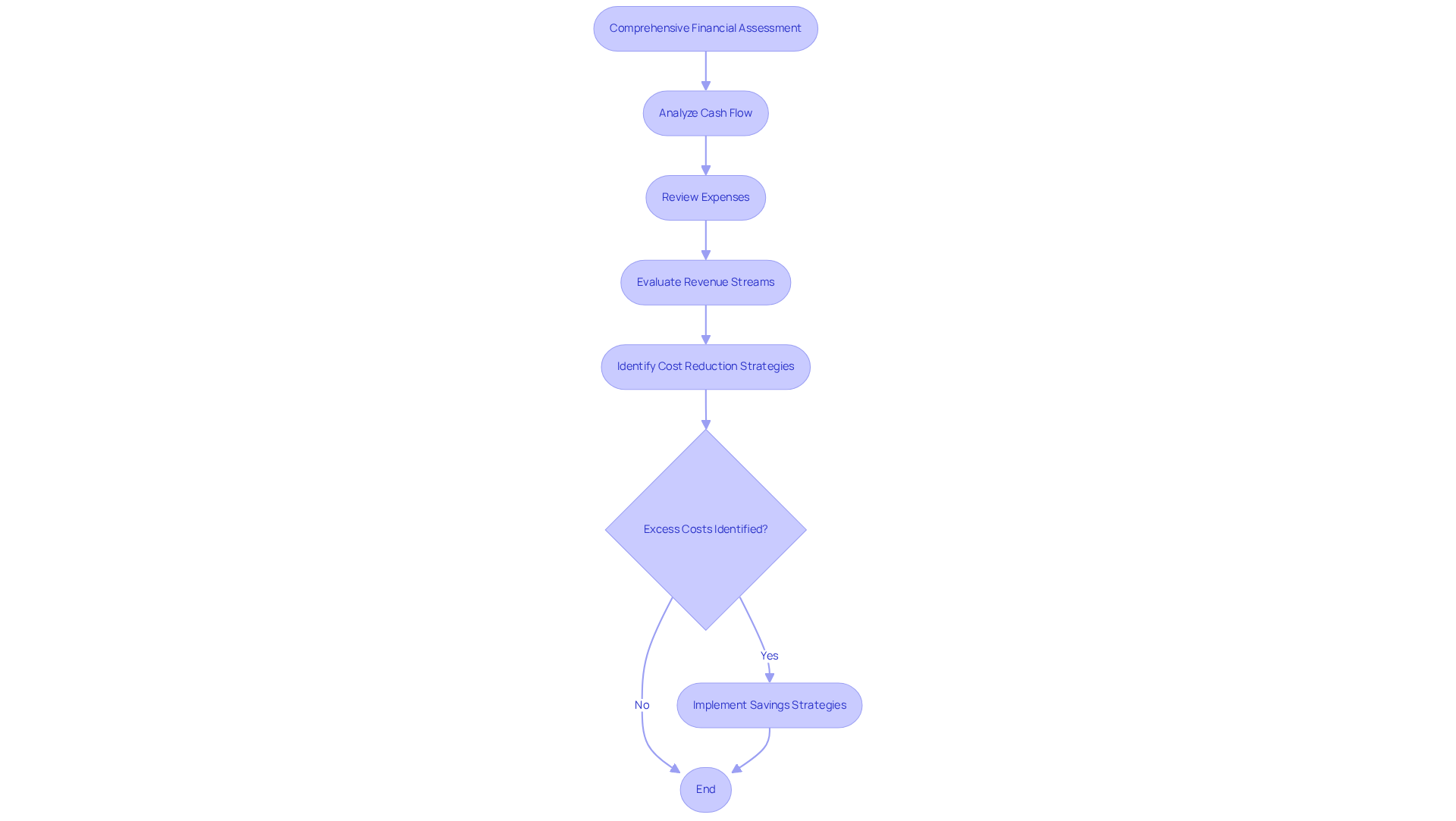
Renegotiate Vendor Contracts: Unlock Savings Through Strategic Negotiation
Renegotiating vendor contracts is a powerful strategy for cost reduction that can achieve significant savings. Businesses must conduct regular reviews of their contracts to ensure they are receiving optimal terms. This process involves gathering competitive quotes, understanding current market rates, and being prepared to negotiate for improved pricing or payment conditions.
For instance, in the restaurant sector, an establishment can leverage its loyalty and volume purchasing to renegotiate supply contracts, potentially securing discounts or more favorable payment terms. Research indicates that companies can save an average of 9.2% on their total contract value through effective negotiation. Moreover, exploring alternative suppliers can enhance leverage during discussions, especially if current vendors are resistant to negotiation.
Incorporating strategic negotiation tactics can lead to substantial economic advantages. Procurement specialists emphasize the importance of preparation and market knowledge, stating that a well-informed approach can significantly influence the outcome of negotiations. By adopting strategies for cost reduction, companies can unlock savings and enhance their overall financial health.

Consolidate Suppliers: Streamline Procurement for Enhanced Cost Efficiency
Consolidating suppliers can be considered one of the strategies for cost reduction, leading to improved pricing and reduced administrative expenses. By collaborating with fewer suppliers, organizations can adopt strategies for cost reduction that enable them to negotiate bulk purchasing agreements, often resulting in significant discounts. This strategy includes strategies for cost reduction by streamlining the procurement process, minimizing the time spent managing multiple vendor relationships and enabling more decisive actions based on real-time analytics.
For example, a small manufacturing firm could reduce its raw material suppliers from five to two. This consolidation enables strategies for cost reduction by facilitating more streamlined ordering processes and better pricing due to increased order volumes. Implementing strategies for cost reduction not only saves money but also fosters stronger supplier relationships, enhancing service and reliability. Furthermore, by consistently tracking supplier performance through real-time analytics, companies can make informed adjustments to their procurement strategies for cost reduction, ensuring ongoing financial efficiency and operational effectiveness.
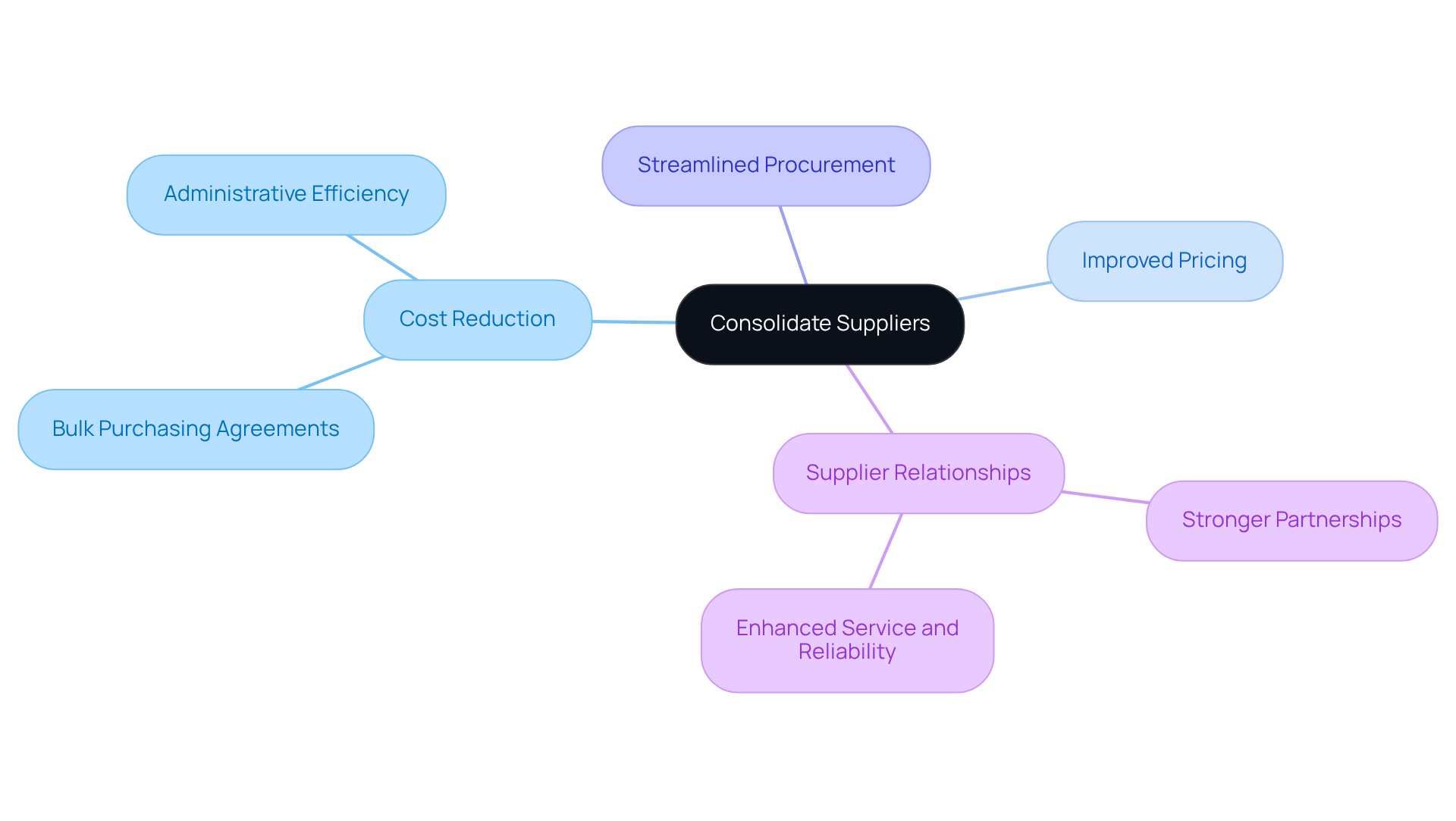
Implement E-Procurement Software: Automate Purchasing to Cut Costs
Implementing e-procurement software significantly streamlines purchasing processes, minimizes manual errors, and provides enhanced visibility into spending. These systems automate critical tasks such as order approvals, invoice processing, and supplier management, allowing staff to concentrate on strategic initiatives rather than routine operations.
For instance, small businesses leveraging e-procurement tools can establish automated workflows for purchasing approvals, ensuring that all acquisitions are necessary and adhere to budget constraints. This method not only involves strategies for cost reduction but also strengthens adherence to company policies and improves overall procurement efficiency. Studies show that organizations implementing thorough procurement strategies for cost reduction generally attain reductions of 8-15% in the initial year, with continued yearly reductions of 3-5% thereafter. Moreover, companies utilizing procurement software report a 12-18% reduction in total spend, which showcases effective strategies for cost reduction through automation in procurement.
Additionally, automated workflows can cut the approval time of purchase orders by 45-55%. Notably, 54% of procurement organizations have reported substantial improvements in operational efficiency from automation. With the procurement software market expected to reach USD 18.76 billion by 2032, the significance and uptake of these technologies are becoming increasingly vital for organizations seeking strategies for cost reduction and improved performance.
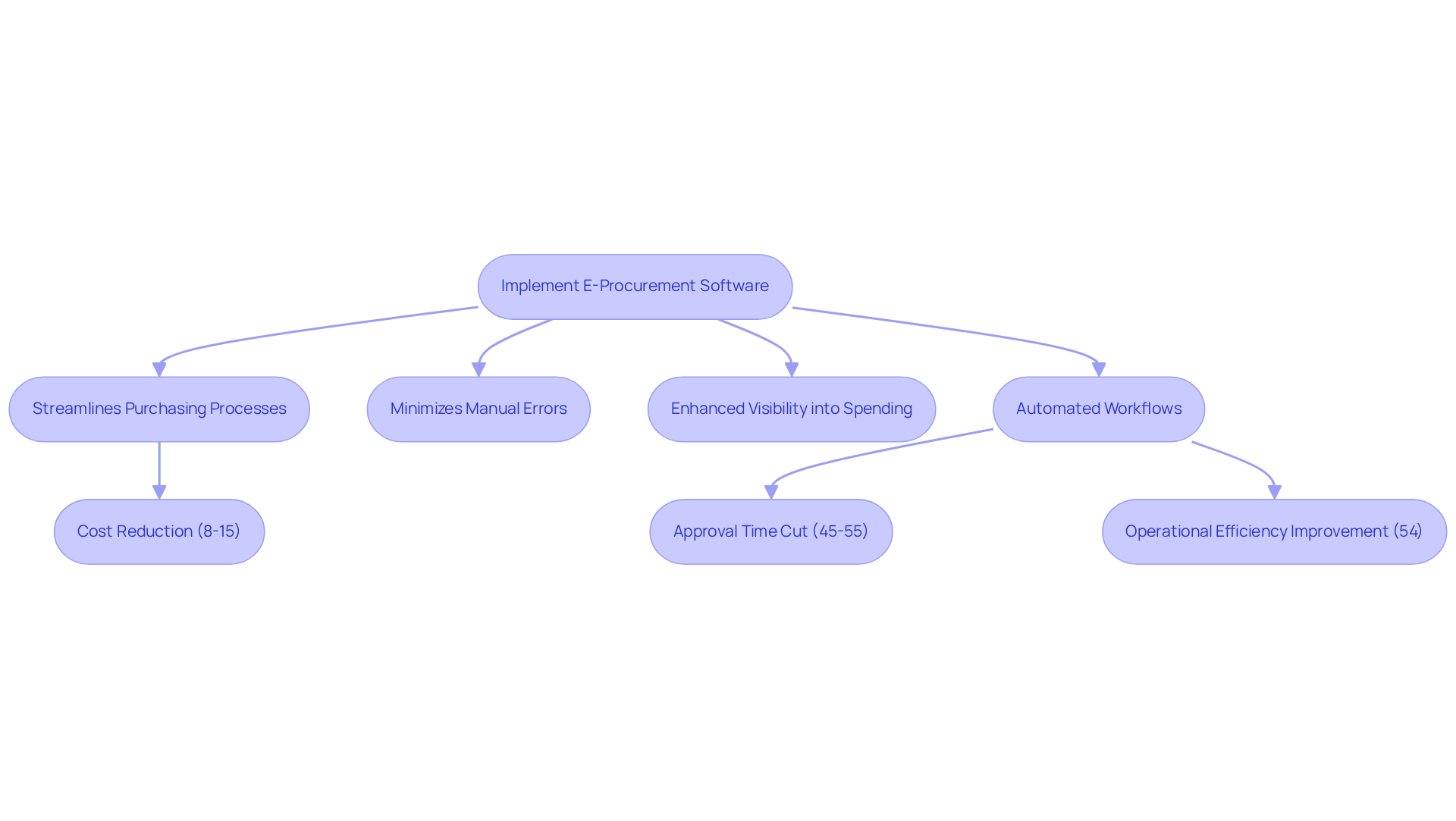
Embrace a Remote Work Model: Reduce Overhead and Enhance Flexibility
Adopting a remote work model is one of the strategies for cost reduction that can lead to substantial reductions in office space, utilities, and other overhead expenses. By enabling employees to work from home, businesses can adopt strategies for cost reduction by minimizing their physical footprint and the associated costs.
For example, a tech startup could implement strategies for cost reduction by transitioning to a fully remote model, potentially saving thousands annually on rent and utilities. Moreover, remote work can significantly enhance employee satisfaction and productivity, as workers benefit from increased flexibility and reduced commuting times. Consequently, companies should invest in essential technology and tools to support remote work, ensuring that employees remain connected and productive.
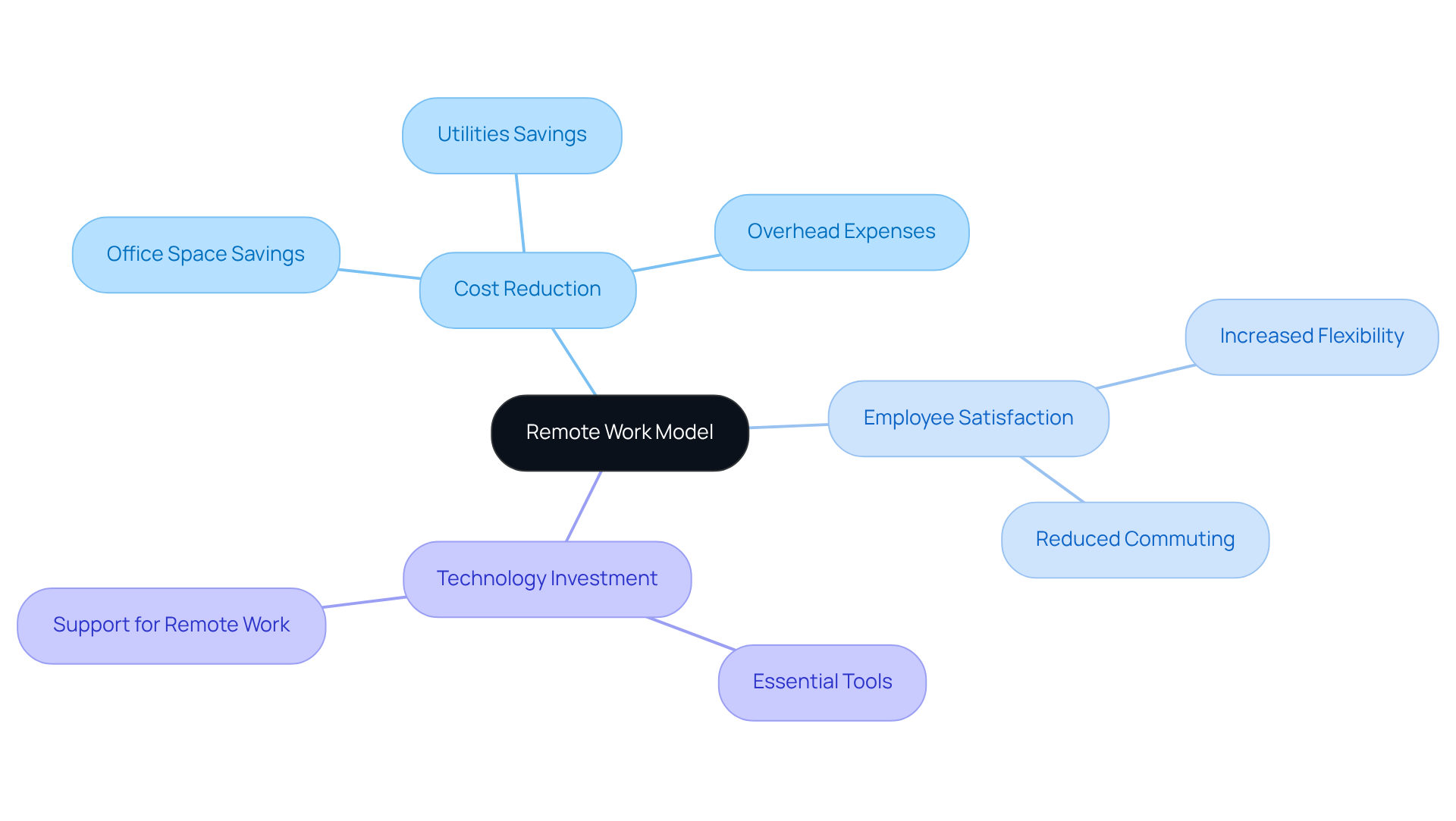
Review and Renegotiate Office Leases: Optimize Space for Cost Savings
Reviewing and renegotiating office leases can yield significant savings by implementing strategies for cost reduction, particularly when informed by real-time analytics and strategic planning. Businesses must assess their current space needs through data-driven insights to determine if they are overpaying for unused or underutilized space. Engaging with property owners to negotiate improved terms or consider strategies for cost reduction, such as downsizing alternatives, can lead to considerable savings.
For instance, a small enterprise that has transitioned to a hybrid work model may find that it no longer requires as much office space. By leveraging analytics to apply strategies for cost reduction, such as renegotiating their lease for reduced square footage or securing a lower rate, they can free up capital for other investments. This strategic approach not only enhances expenses but also empowers companies to reinvest in essential strengths, thereby boosting overall performance.
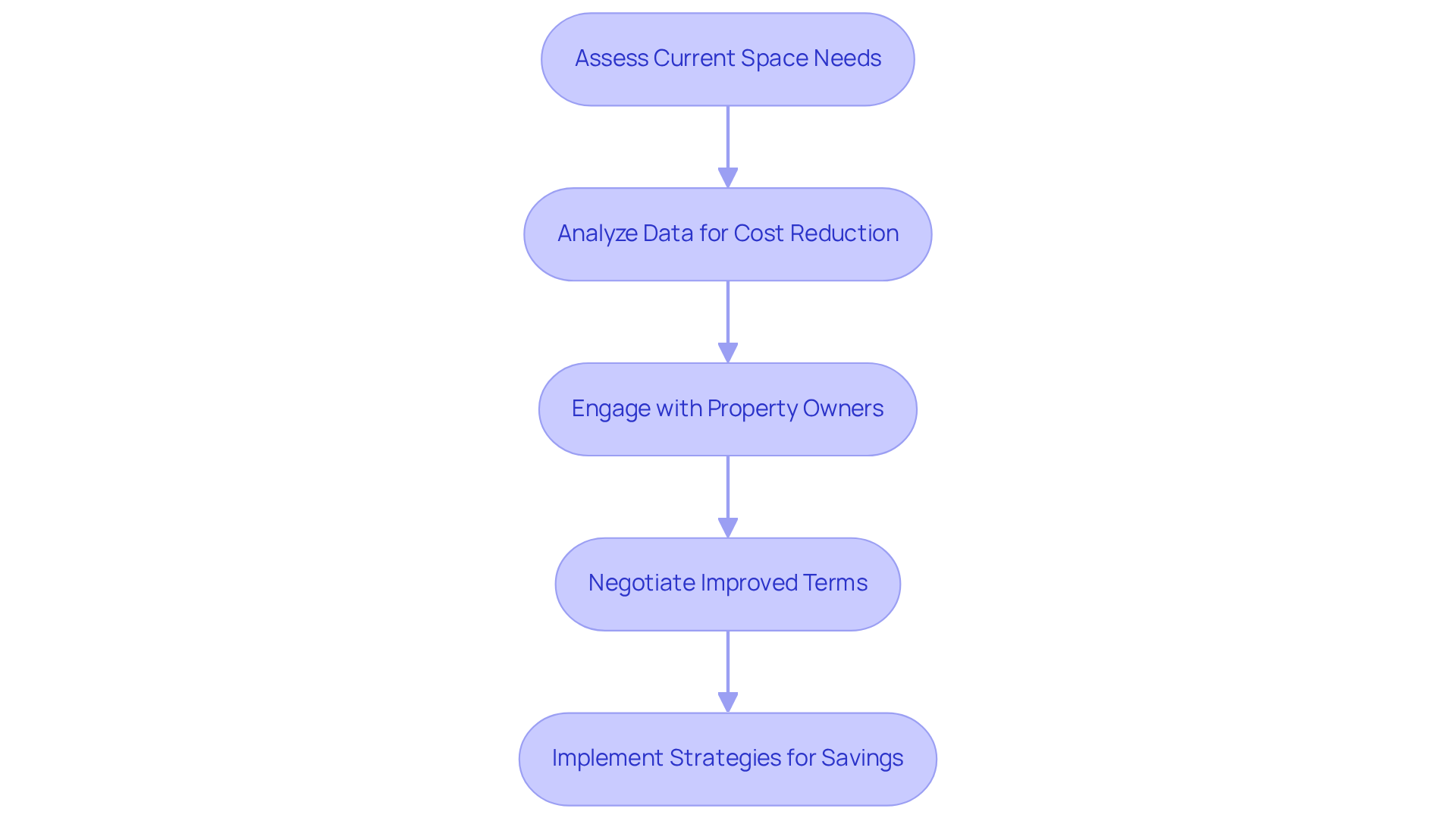
Leverage Accounting Automation: Enhance Efficiency and Reduce Costs
Harnessing the power of accounting automation can significantly enhance efficiency and support strategies for cost reduction associated with manual financial processes. Automated systems adeptly manage tasks such as invoicing, expense tracking, and financial reporting, thereby minimizing the necessity for extensive manual input.
For instance, a small business can leverage accounting software that automates invoice generation and payment reminders, effectively reducing the time allocated to accounts receivable. This not only lowers labor expenses but also enhances cash flow management through strategies for cost reduction that ensure prompt payments. Furthermore, by integrating real-time analytics into these automated systems, organizations can continuously monitor their financial health, facilitating streamlined decision-making that promotes optimal performance and boosts overall profitability.
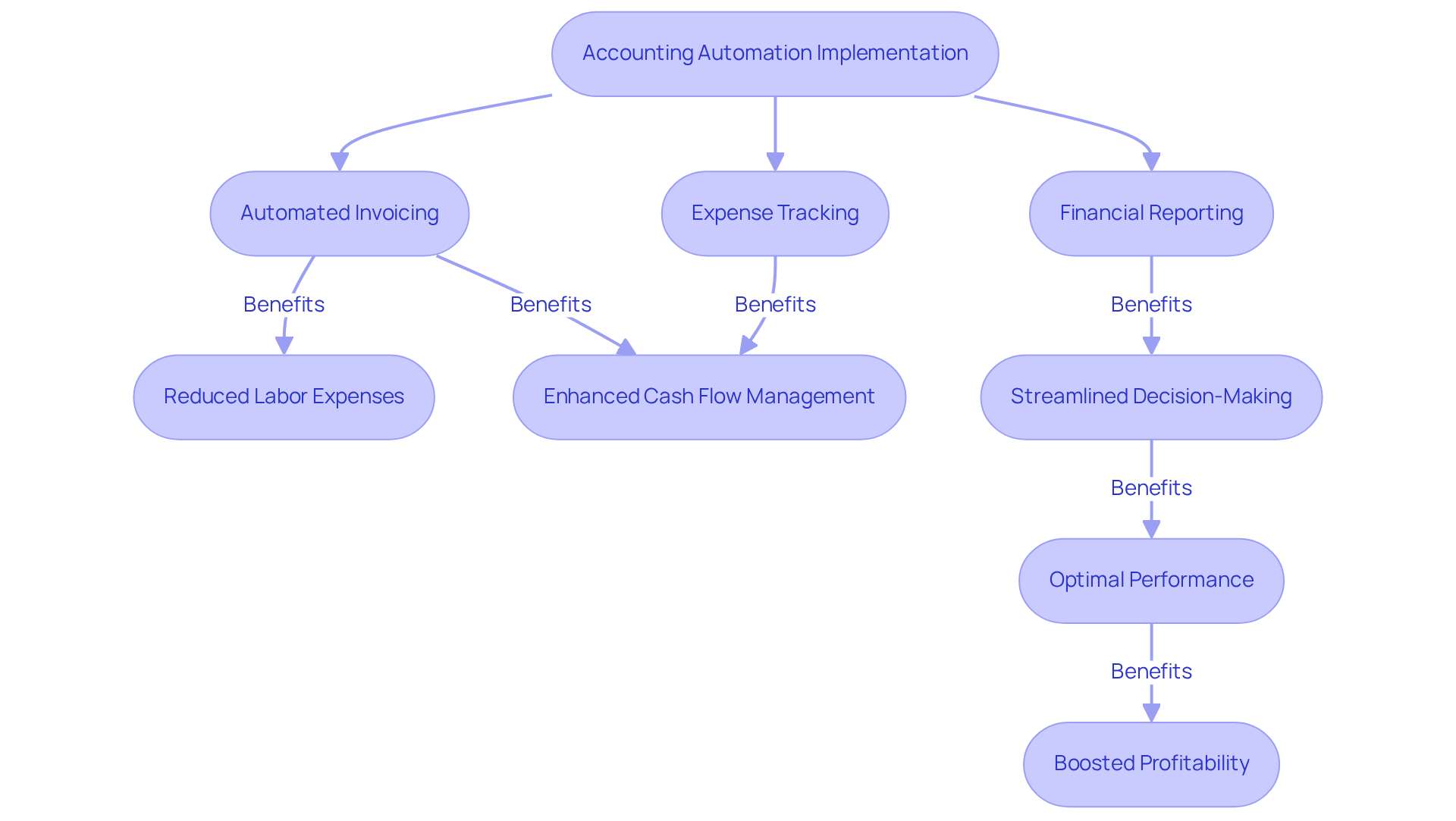
Review and Reduce Subscriptions: Eliminate Unnecessary Expenses
Businesses must regularly review their subscription services to identify those that are no longer necessary or underutilized. This encompasses software subscriptions, memberships, and other recurring expenses. By utilizing strategies for cost reduction, such as eliminating or consolidating these subscriptions, companies can free up valuable resources and reinvest in their key strengths. Recognizing fundamental issues and collaborating to develop a strategy to address them is crucial, as it ensures that every decision contributes to maximizing returns on investment.
For instance, a marketing agency may discover that it is paying for multiple design software subscriptions when a single comprehensive tool would suffice. By consolidating these services, they can apply strategies for cost reduction while still fulfilling their operational needs, ultimately enhancing their overall business performance.
Thus, it is imperative for businesses to take action now—review your subscriptions, eliminate redundancies, and apply strategies for cost reduction to unlock potential savings and drive growth.
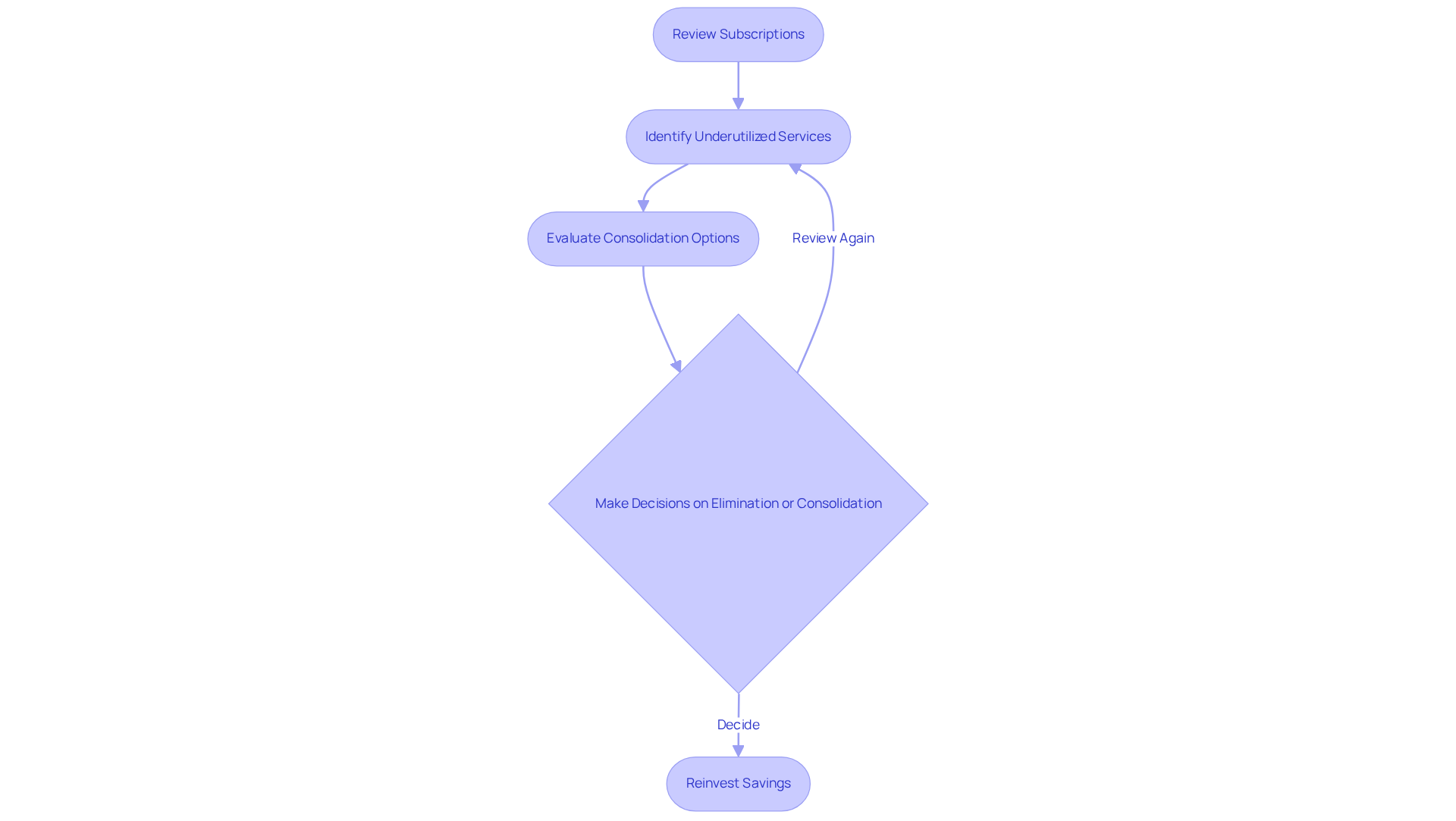
Promote a Cost-Conscious Culture: Foster Awareness for Long-Term Savings
Cultivating a cost-conscious culture within an organization is essential for developing strategies for cost reduction and enhancing overall efficiency. Encouraging employees to be vigilant about spending and actively pursue strategies for cost reduction can significantly impact the bottom line. This can be achieved through:
- Comprehensive training programs
- Clear communication regarding monetary goals
- Acknowledging employees who propose innovative strategies for cost reduction
For instance, establishing a rewards program for staff who suggest strategies for cost reduction not only enhances engagement but also fosters a sense of ownership over the company's economic health. Research indicates that organizations with engaged employees experience higher productivity and lower turnover rates, which directly contributes to cost savings. By nurturing a culture where employees feel appreciated and empowered, organizations can establish a setting favorable to ongoing enhancement and financial prosperity.
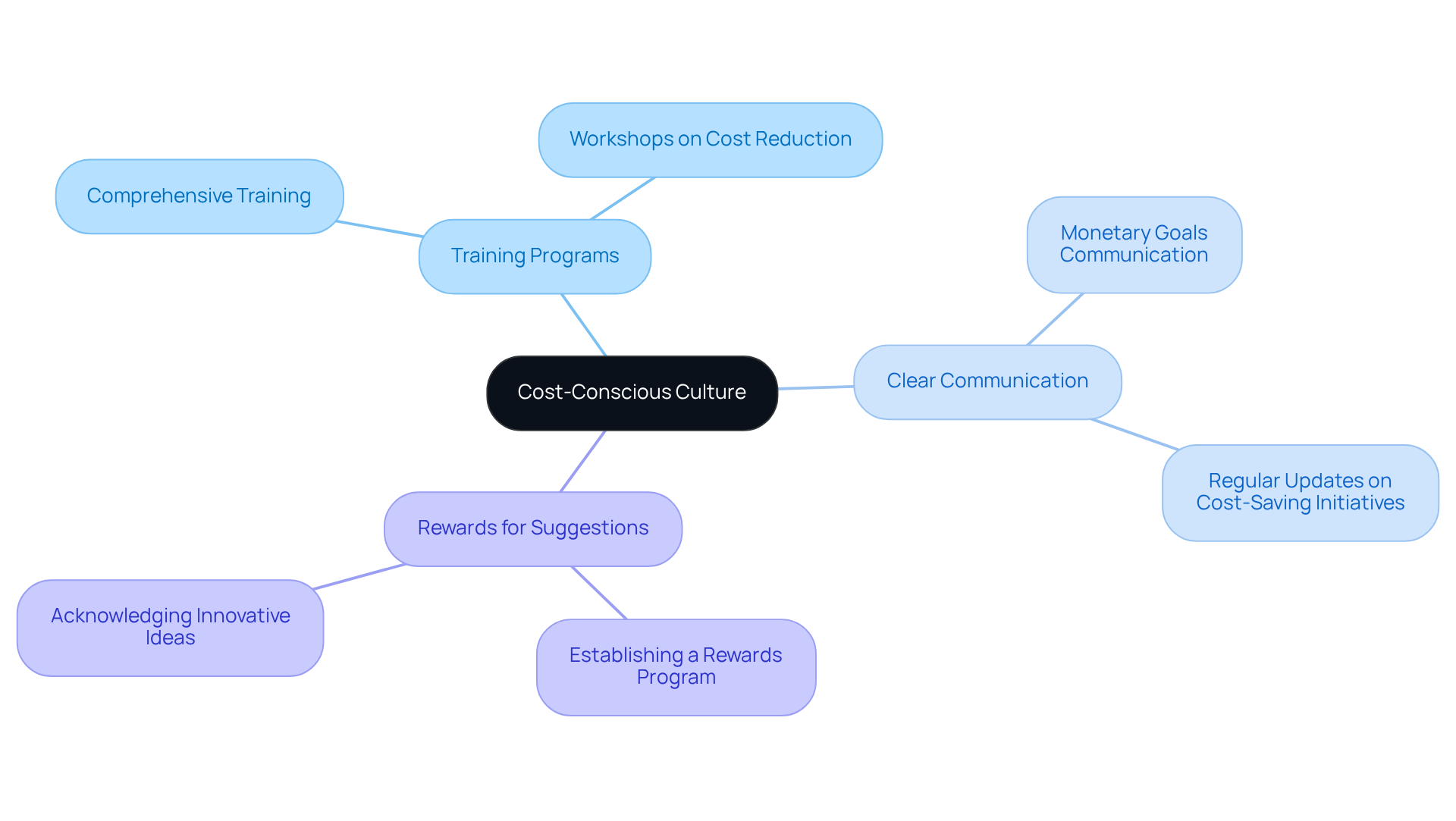
Reduce Business Travel Expenses: Optimize Travel Policies for Savings
Minimizing travel expenses necessitates a strategic approach to travel policies. Companies should establish clear guidelines for travel bookings, including preferred vendors, travel classes, and spending limits. By optimizing these policies, businesses can adopt strategies for cost reduction while still meeting travel needs.
For instance, implementing a policy that encourages employees to book flights in advance and use economy class for domestic travel can significantly reduce expenses. Moreover, utilizing travel management software allows firms to track expenses effectively and identify strategies for cost reduction, including negotiating corporate rates with airlines and hotels.
Consequently, adopting a comprehensive travel policy not only fosters strategies for cost reduction but also enhances employee satisfaction by ensuring their travel needs are met without overspending.
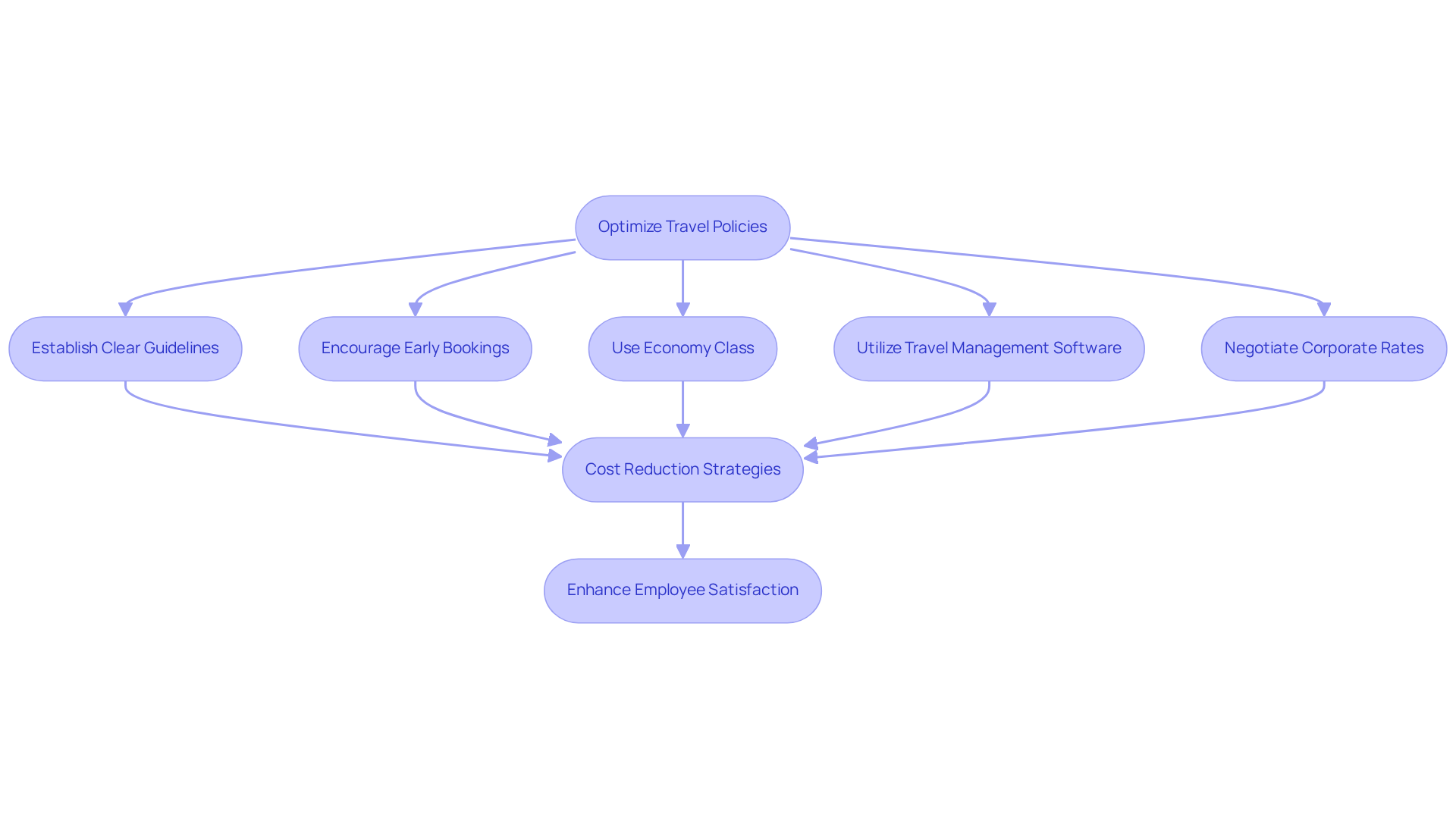
Conclusion
Implementing effective cost reduction strategies is paramount for businesses aiming to enhance their efficiency and profitability. By adopting a multifaceted approach that includes:
- Thorough financial assessments
- Renegotiating vendor contracts
- Embracing technology like e-procurement software
companies can uncover significant savings. Each strategy discussed emphasizes the importance of proactive management and informed decision-making to streamline operations and optimize resources.
Key insights from the article highlight the potential for substantial savings through:
- Supplier consolidation
- Automation of accounting processes
- Fostering a cost-conscious culture among employees
By prioritizing these strategies, businesses can not only reduce expenses but also create a more agile and responsive organization. The examples provided illustrate how companies across various sectors can implement these tactics effectively, leading to immediate and long-term financial benefits.
Ultimately, the call to action is clear: businesses must actively engage in reviewing their practices and seeking out innovative solutions for cost reduction. By doing so, they position themselves for sustainable growth and resilience in a competitive marketplace. Embracing these strategies not only drives down costs but also cultivates a culture of efficiency and accountability, ensuring that every dollar spent contributes to the overarching goals of the organization.
Frequently Asked Questions
Why is a comprehensive financial assessment important for small and medium businesses?
A comprehensive financial assessment is essential for revealing strategies for cost reduction and improving operational efficiency. It involves analyzing cash flow, expenses, and revenue streams to identify excessive costs and uncover potential savings.
How can businesses identify areas for cost reduction?
Businesses can identify areas for cost reduction by scrutinizing financial reports, which help assess their overall economic condition and uncover excessive costs. Strategies may include eliminating duplicate services and refining pricing strategies.
What role does financial software play in cost reduction assessments?
Financial software can streamline the assessment process by providing real-time insights into spending patterns and cash flow management, aiding in immediate expense reduction and facilitating sustainable growth.
How can renegotiating vendor contracts contribute to cost reduction?
Renegotiating vendor contracts can achieve significant savings by ensuring businesses receive optimal terms. This involves gathering competitive quotes, understanding market rates, and negotiating for better pricing or payment conditions.
Can you provide an example of how renegotiation can lead to savings?
In the restaurant sector, a business can leverage its loyalty and volume purchasing to renegotiate supply contracts, potentially securing discounts or more favorable payment terms, which can lead to an average savings of 9.2% on total contract value.
What is the benefit of consolidating suppliers for cost reduction?
Consolidating suppliers can lead to improved pricing and reduced administrative expenses by enabling organizations to negotiate bulk purchasing agreements, resulting in significant discounts and a more streamlined procurement process.
How does supplier consolidation enhance operational efficiency?
By collaborating with fewer suppliers, businesses can minimize the time spent managing multiple vendor relationships, streamline ordering processes, and foster stronger supplier relationships, enhancing service and reliability.
What is the importance of tracking supplier performance?
Consistently tracking supplier performance through real-time analytics allows companies to make informed adjustments to their procurement strategies, ensuring ongoing financial efficiency and operational effectiveness.




